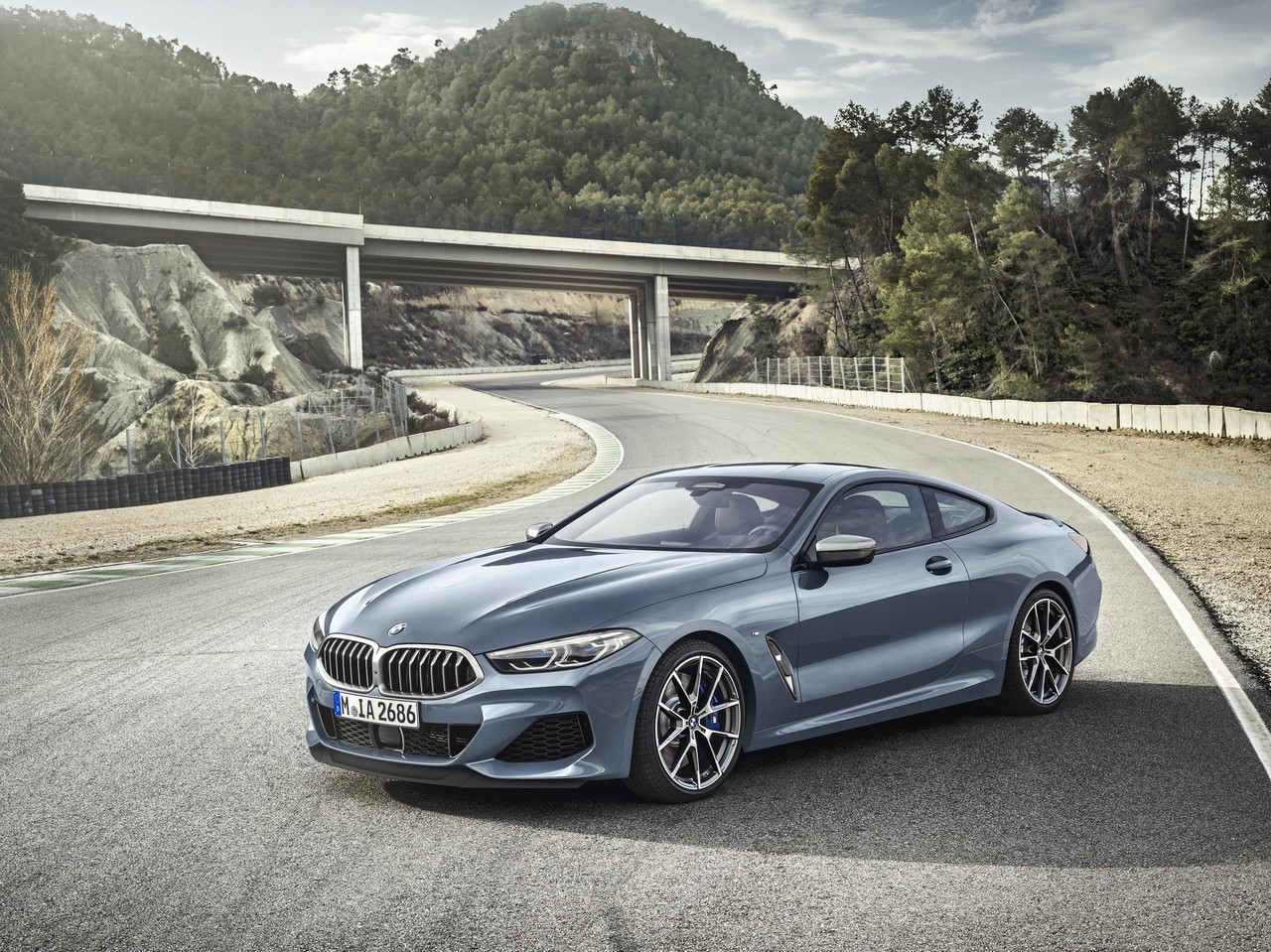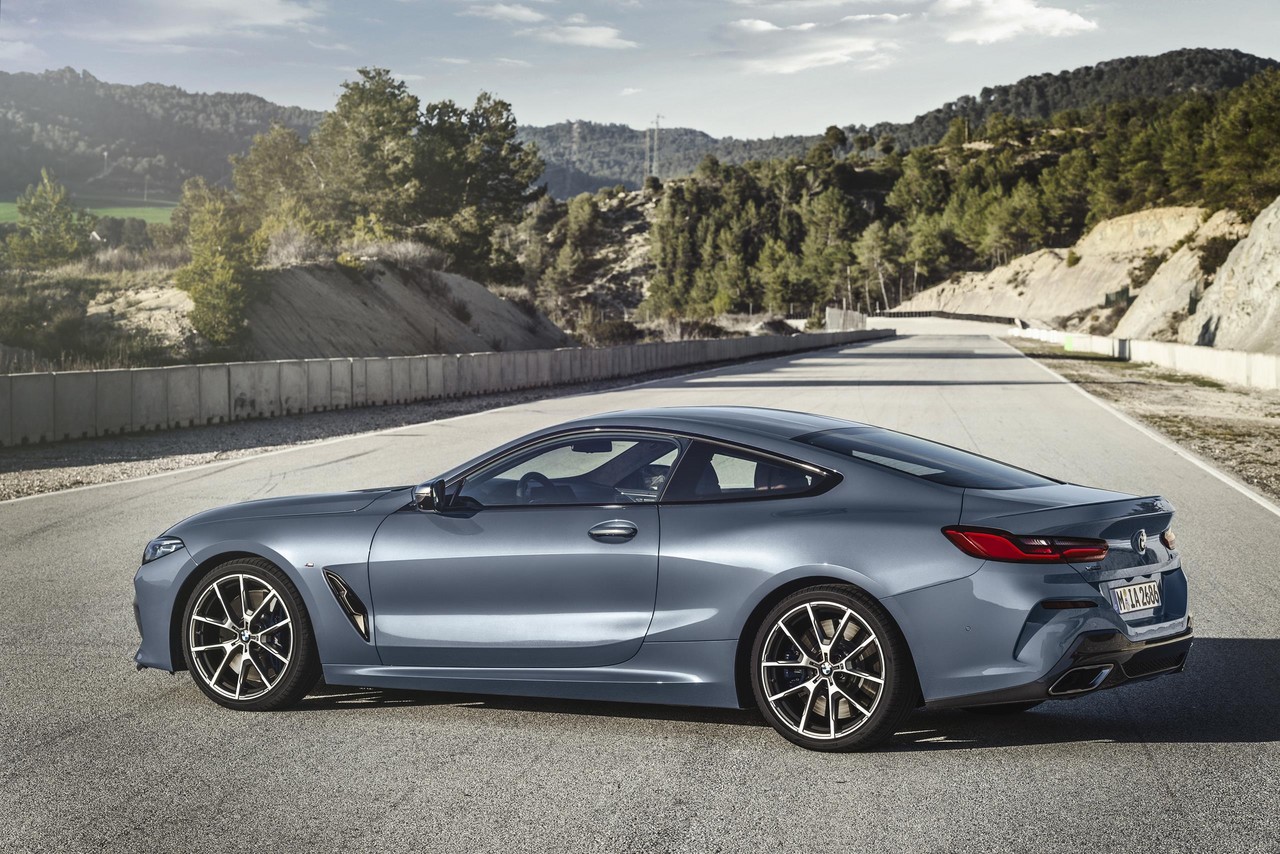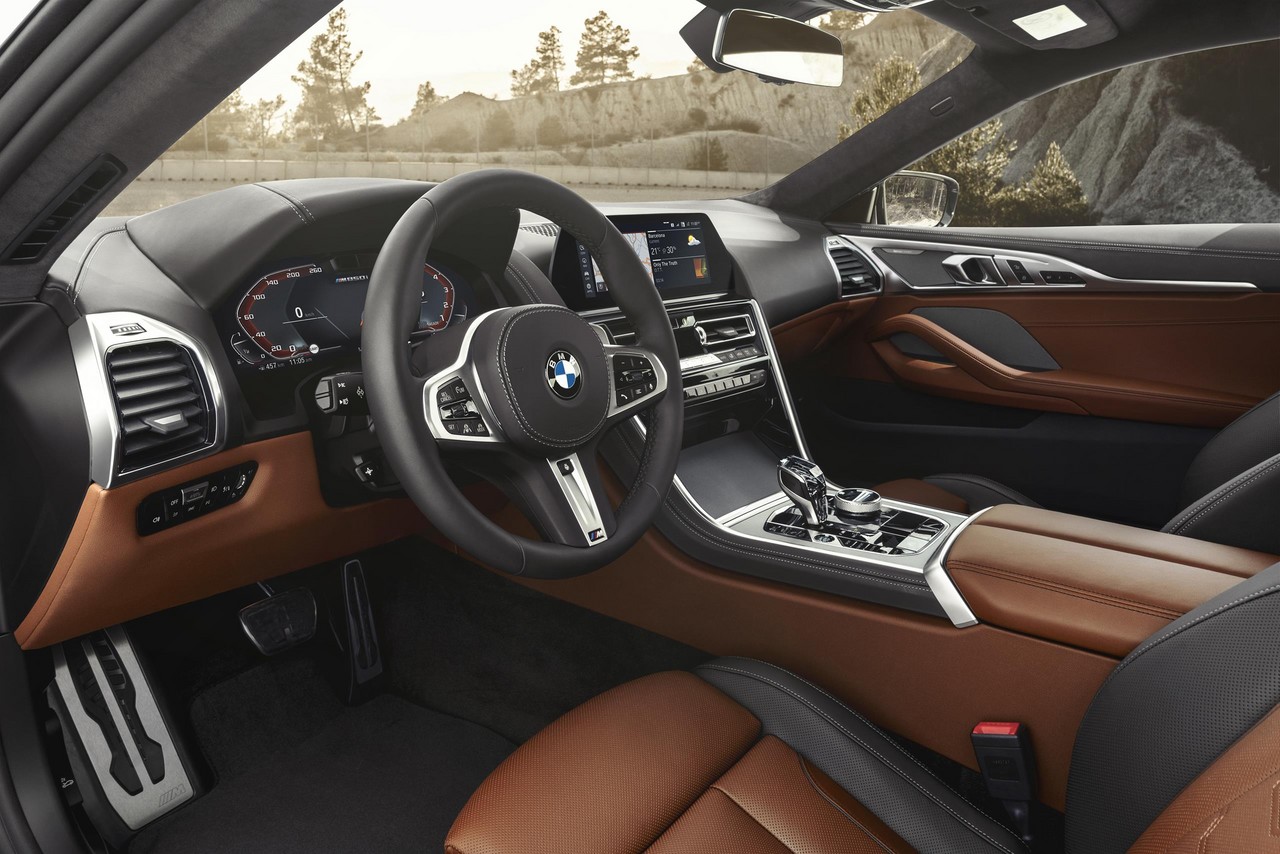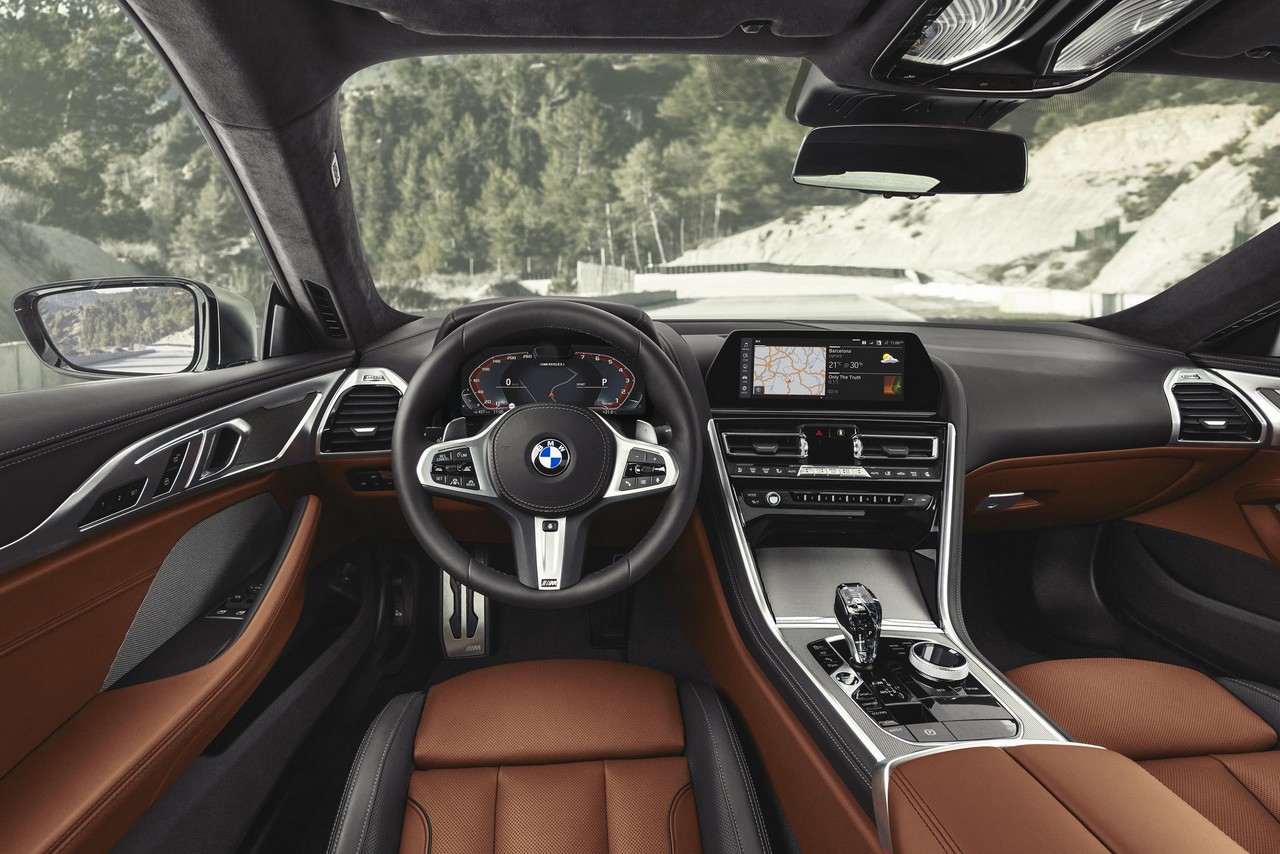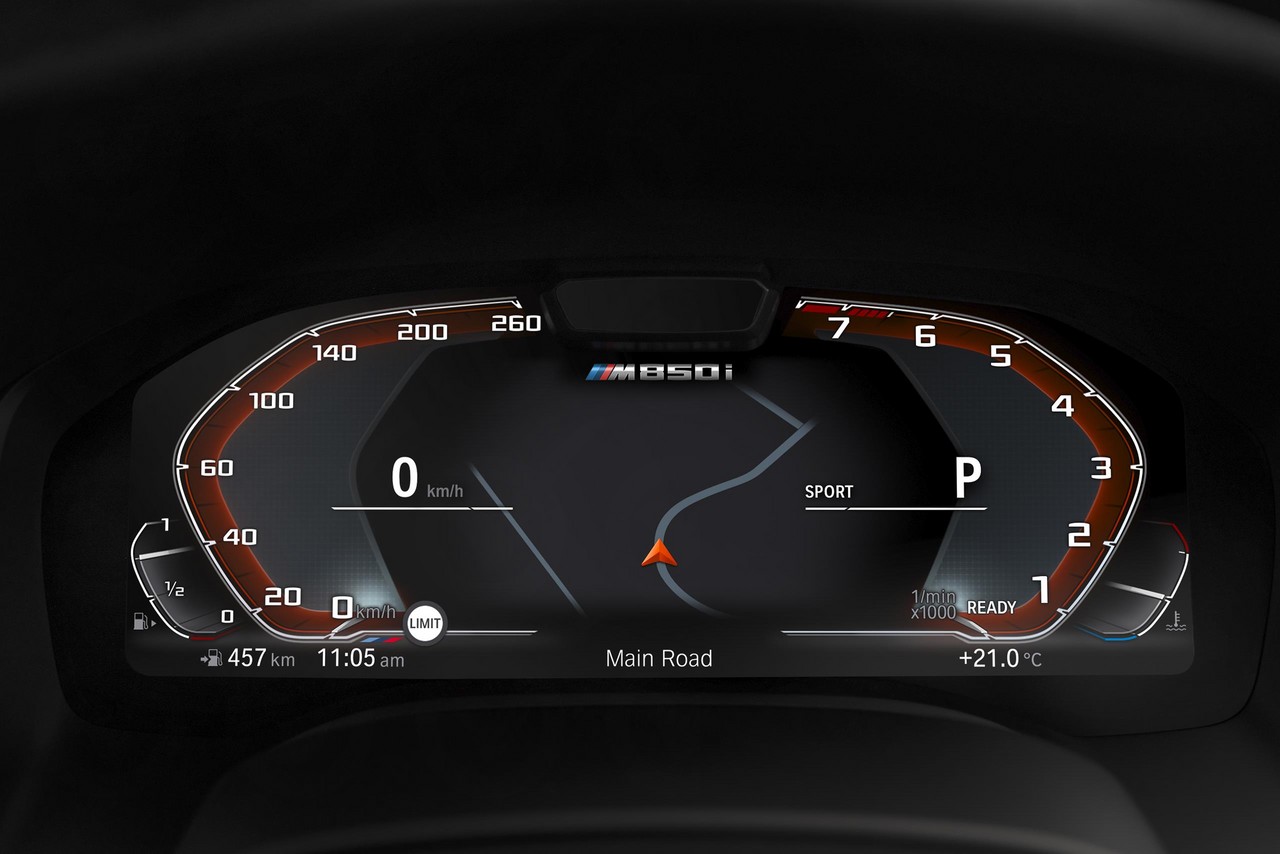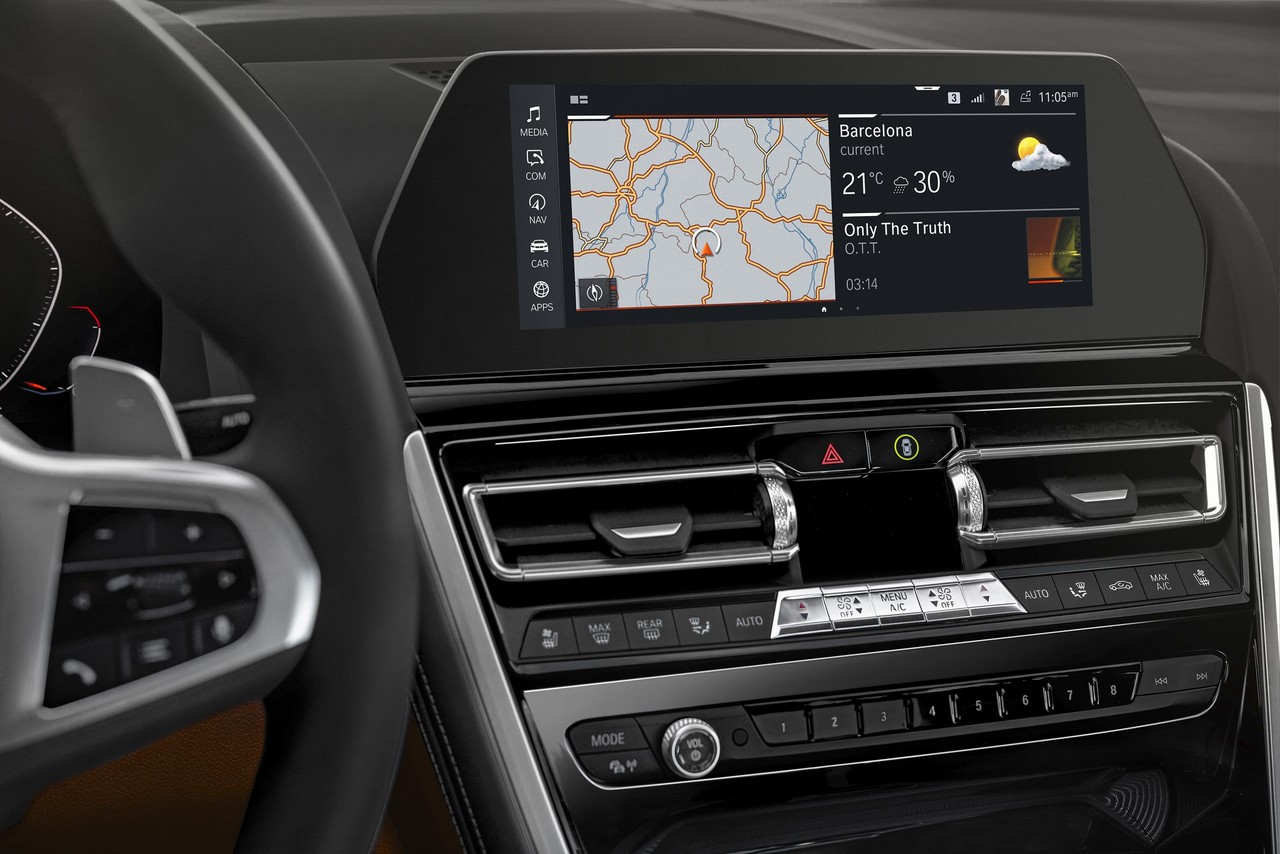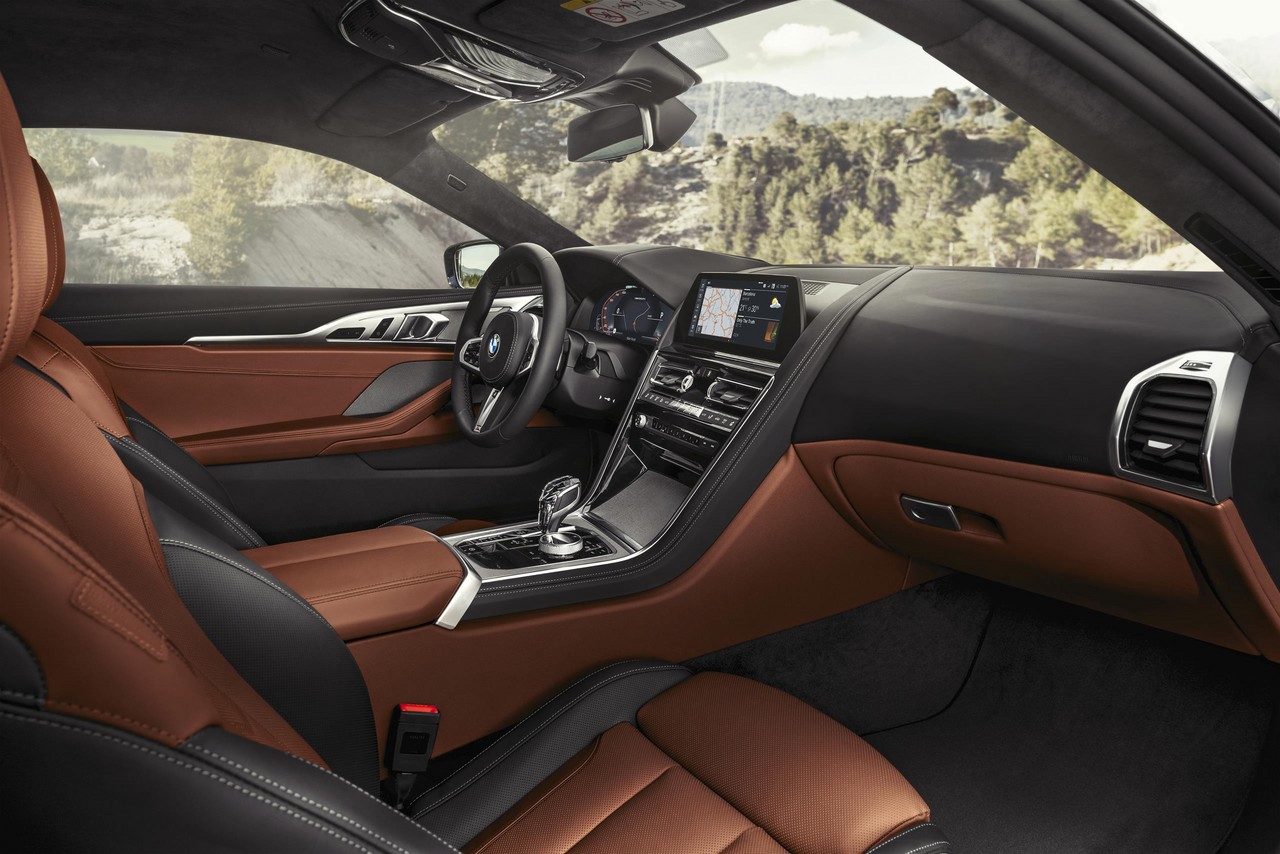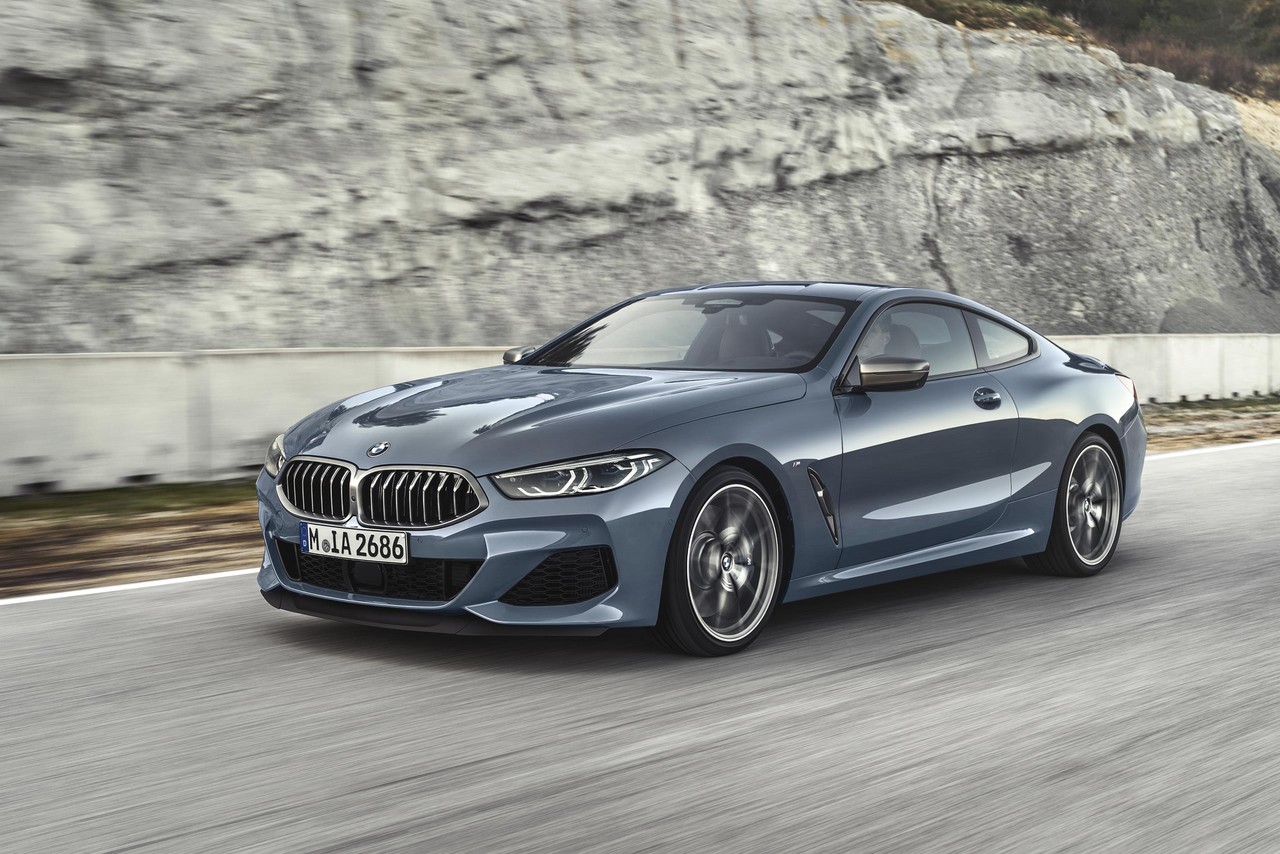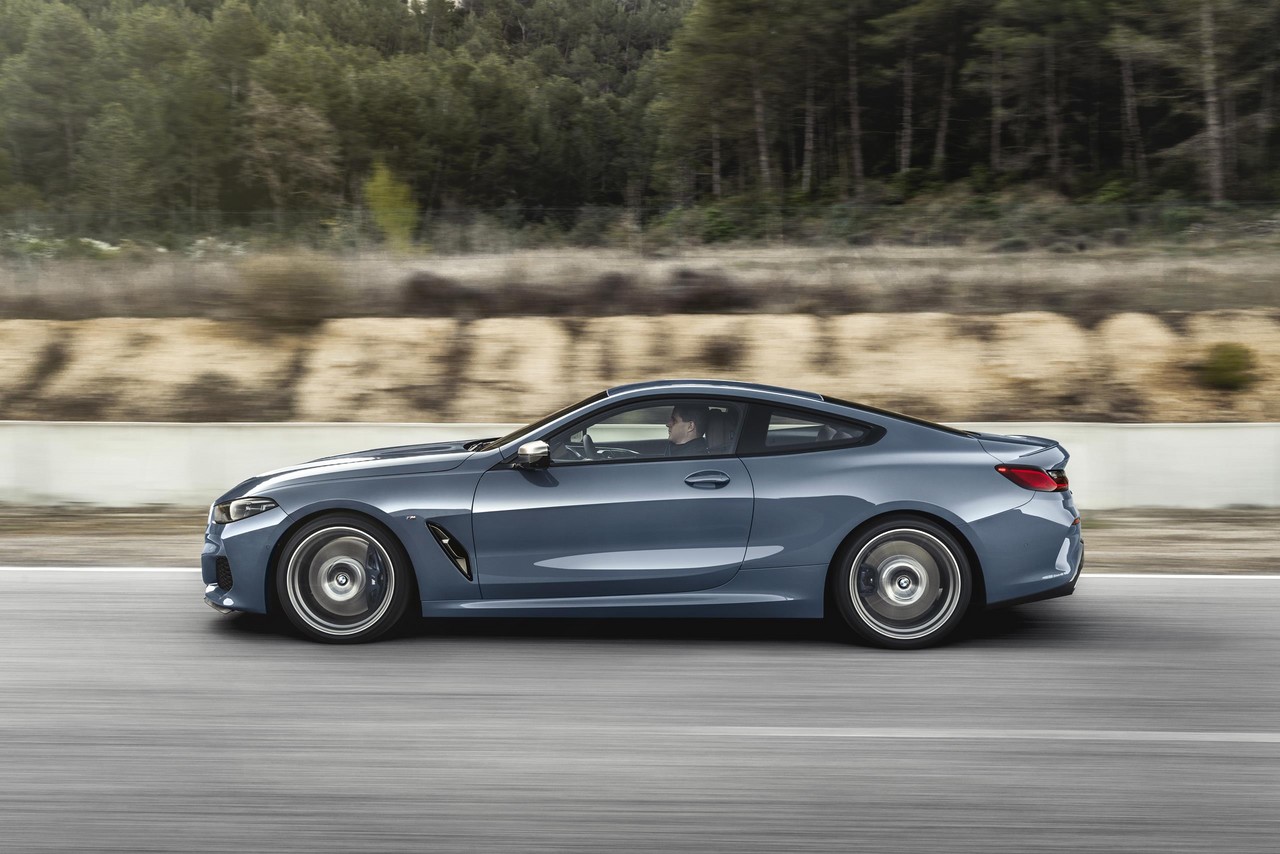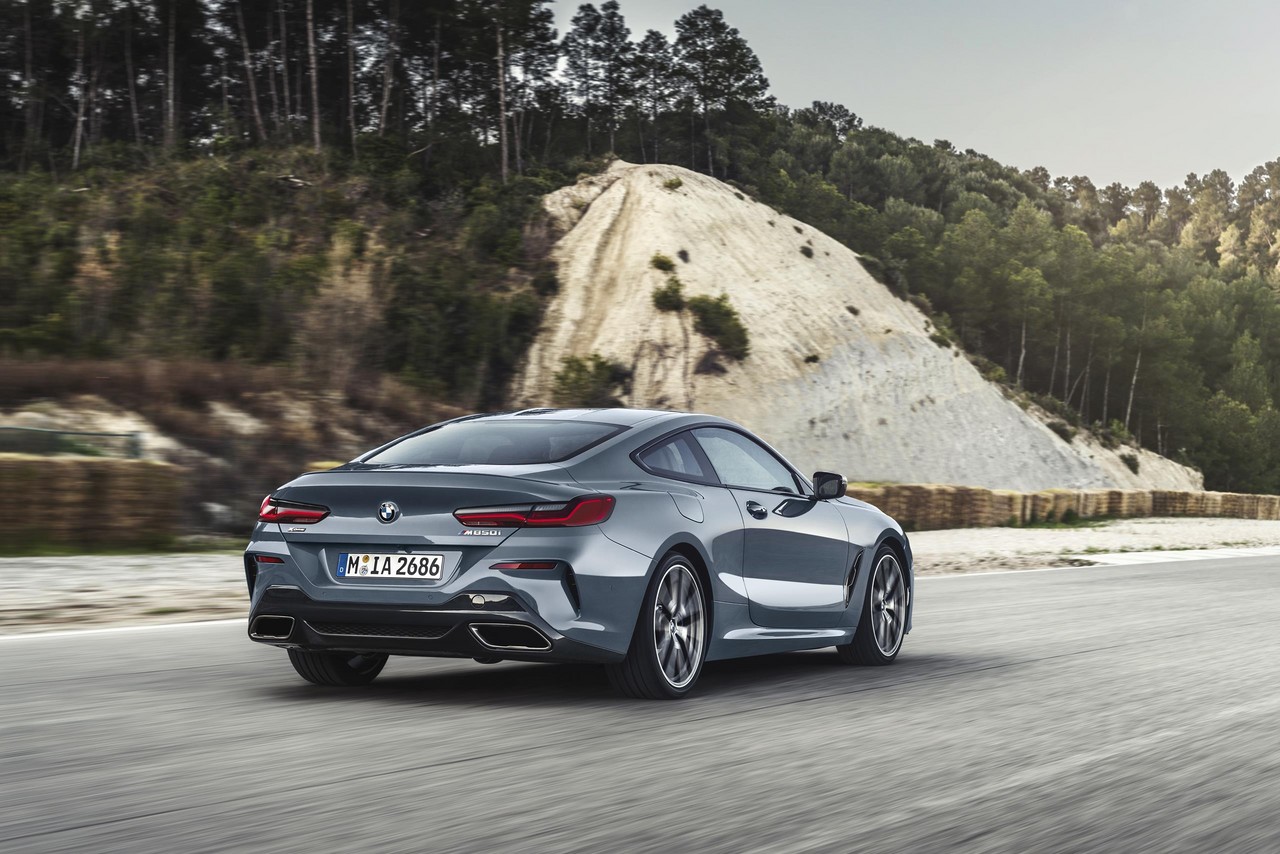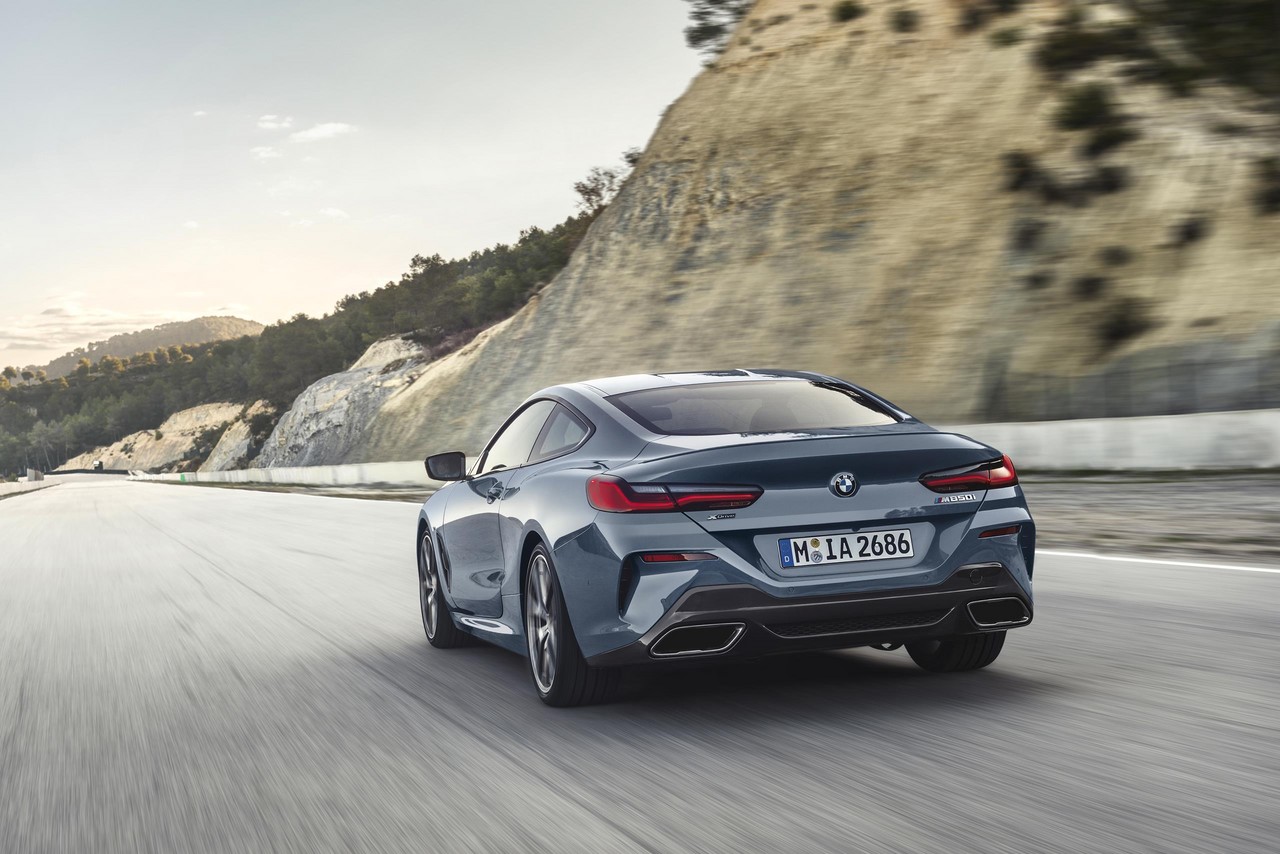
- Powerful 4.4-litre N63B44TU3 biturbo V8 engine for M850i
- Refined eight-speed automatic transmission
- xDrive contributes to impressive dynamics
- Comfortable and supportive front seats
- Good boot space for a GT (420 litres)
- Intuitive iDrive infotainment system (finally!)
- Steering lacks feedback
- Body control prioritised over ride quality
- Interior lacks the style of Audi and Mercedes rivals
- Digital instrument cluster not as easy to read as conventional dials
Overview
Released in Australia in May 2019, the BMW G15 8-Series was a four-seat coupe. For Australia, the G15 8-Series Coupe range was limited to the M850i variant which was powered by BMW’s 4.4-litre N63B44 biturbo V8 petrol engine. While the G15 8-Series effectively replaced the BMW F13 6-Series Coupe , it was the second-generation 8-Series after the original E31 8-Series that was released in 1990.
To reduce fuel consumption, the BMW G15 M850i Coupe had:
- An ‘Auto Start Stop’ function which could shut down the engine based on data supplied by the navigation system, camera and radar sensors of the driver assistance systems;
- An ‘Eco Pro’ mode which adjusted engine management, throttle response and transmission behaviour to minimise fuel consumption. Eco Pro also included a coasting function that could disengage the engine from the drivetrain at speeds between 15 km/h and 160 km/h when the driver eased off the accelerator; and,
- ‘Brake Energy Regeneration’ which increased alternator output to recharge the battery when the vehicle was coasting or braking.
Over the combined EU test cycle, fuel consumption for the BMW G15 M850i was 10.0 litres per 100 km. Furthermore, the BMW G15 M850i could accelerate from rest to 100 km/h in 3.9 seconds.
Production of the BMW G15 8-Series Coupe commenced in Dingolfing, Germany, in November 2018.
| Engine | Trans. | Peak power | Peak torque | |
|---|---|---|---|---|
| M850i xDrive | 4395 cc N63B44TU3 biturbo petrol V8 | 8sp auto | 390 kW at 5500-6000 rpm | 750 Nm at 1800-4600 rpm |
xDrive all-wheel drive system
The all-wheel drive system for the BMW G15 8-Series had an electronically controlled, multi-plate clutch in the transfer case. Where all-wheel drive was not required, all of the engine’s torque was directed to the rear wheels to reduce fuel consumption. Where all-wheel drive was required, or sensors anticipated that additional traction may be required, the multi-plate clutch would engaged to distribute torque to the front axle. When active, the ‘xDrive’ all-wheel drive system had a rear bias.
As standard, the BMW G15 M850i xDrive was equipped with an electronically controlled rear differential lock. Controlled by the electronic stability control system (BMW’s ‘DSC’), the locking function for the rear differential could prevent a wheel from spinning in low-traction situations, thereby improving traction and power transmission when driving on loose ground or surfaces with variable grip levels. The locking effect was achieved by an electric motor that allowed up to 1500 Nm of drive torque to be redirected from the faster-turning (i.e. low traction) wheel to the slower-turning wheel.
Body and dimensions
The BMW G15 8-Series Coupe was underpinned by BMW’s CLAR platform and, to reduce weight, used:
- Aluminium for supporting structures at the front and rear of the body and for the roof, doors, bonnet and front wall;
- Magnesium for the cockpit bracing tube; and,
- Carbon fibre reinforced plastic (CFRP) for the centre transmission tunnel. As an option, the roof and other body components could be specified in CFRP.
Compared to the BMW F13 6-Series Coupe which it replaced, the G15 8-Series Coupe was 51 mm shorter (4843 mm), 8 mm wider (1902 mm), 28 mm lower (1341 mm) and has a 33 mm shorter wheelbase (2822 mm), while boot capacity was 420 litres. Drag co-efficients for the BMW G15 840d and M850i variants were 0.29 Cd and 0.33 Cd, respectively. To achieve these measures, aerodynamic features for the G15 8-Series Coupe included:
- An ‘almost fully sealed’ underbody;
- Active air flap control with adjustable kidney grille slats;
- Air Curtains (vertical apertures which guided inflowing air around the wheel arches to create a curtain of air over the wheels);
- Air Breathers (once air was deflected around the wheel arches, it was channelled through Air Breathers that were positioned behind the front wheels);
- Narrow exterior mirror bases that were mounted directly on the side window weather strips; and,
- Frameless side windows.
Unique within the 8-Series range, the BMW M850i xDrive had an additional front spoiler to reduce front axle lift.
Suspension
The BMW G15 8-Series had double wishbone front suspension – produced from aluminium – with a separate lower track arm. For the five-link aluminium/steel rear axle, the wheel carriers and forged control arms were also produced from aluminium. As standard, the BMW G15 8-Series had BMW’s ‘Adaptive M suspension with Dynamic Damper Control (i.e. electronically controlled dampers) in which compression and rebound stages were adjusted continuously and independently. Design features of the suspension included:
- For stiffness, torsion struts on the front axle and a load-bearing strut that was incorporated on the rear axle;
- Special wheel carriers and wishbones to increase camber;
- Independent rubber bearings to increase camber stiffness; and,
- Additional damping plates at the rear axle to improve dynamic ability.
Fitted as standard for Australian-delivered BMW M850i Coupes, ‘active roll stabilisation’ consisted of anti-roll bars at the front and rear axles that were split and connected in the centre by an electric swivel motor. Actuation of the swivel motor caused the two links on the anti-roll bar to twist and counteract roll forces.
Steering
The BMW G15 8-Series Coupe had rack-and-pinion steering with speed-sensitive electric power assistance (BMW’s ‘Servotronic’) and a variable steering ratio (though the overall ratio is 16.3:1). Furthermore, the G15 8-Series had a turning circle of 11.9 metres.
As standard, the G15 8-Series Coupe was equipped with BMW’s ‘Integral Active Steering’ which provided rear wheel steering. At speeds up to 72 km/h (and up to 88 km/h in Sport and Sport+ drive modes), the rear wheels could turn up to 2.5 degrees in the opposite direction to the front wheels to reduce the turning radius. At higher speeds, however, the rear wheels turned in the same direction as the front wheels for greater stability.
Safety equipment
Standard safety equipment for the BMW G15 8-Series included dual front airbags, dual front knee airbags, front seat-mounted side airbags, full-length curtain airbags (i.e. for front and second row seats), ABS, electronic brake force distribution, electronic stability control, traction control and front seatbelts with pre-tensioners and load limiters.
As standard, the G15 8-Series Coupe was equipped with BMW’s ‘Driving Assistant Professional’. AustralianCar.Reviews understands that this included the following safety technologies –
- Forward Collision Warning and Pedestrian Warning with City Braking: operating at speeds between 10 and 60 km/h, this system would warn the driver if a pedestrian or stationary vehicle was detected in the vehicle’s path. If the driver failed to react, the system would automatically apply the brakes to prevent or minimise the severity of a collision;
- Active Cruise Control with Stop&Go function: at speeds from 30 km/h to 210 km/h, Active Cruise Control could maintain a speed-dependent distance from the vehicle ahead. With the Stop&Go function, the brakes could be applied to bring the G15 8-Series to rest; once the traffic ahead began to accelerate, the 8-Series would automatically accelerate if the vehicle had been stationary for a period of up to 30 seconds;
- Traffic Jam Assist: assumed proximity control and lane-keeping tasks at speeds up to 60 km/h. Specifically, Traffic Jam Assist provided steering assistance to keep the car ‘reliably in the middle of its lane’ provided that the driver had at least one hand on the steering wheel;
- Steering and lane control assistant: operating at speeds up to 210 km/h, the steering and lane control assistant provided ‘comfort-enhancing steering interventions’ to keep the vehicle in its current lane (even where road markings were unclear). In stop-start traffic, the system also used the preceding vehicle as a reference point;
- Lane Keeping Assistant: helped the driver pre-empt hazards by automatically applying corrective steering in three types situations: 1) if the system detected that the vehicle was about to leave the road, 2) if the driver was about to change lanes and had not seen a vehicle in the next lane or 3) if danger was detected due to an approaching vehicle. Furthermore, holding the direction indicator could initiate a lane change;
- Lane Departure Warning: active at speeds above 72 km/h, the driver would be alerted by steering wheel vibrations if the vehicle deviated from its lane without prior activation of the indicators and active steering inputs would bring the vehicle back to its intended lane;
- Lane Change Warning: active at speeds above 10 km/h, Lane Change Warning monitored the zones on each side of the vehicle. If the driver activated the indicators to change lanes, the system would check these zones and – if occupied – warn the driver via steering wheel vibrations and flashing a symbol in the respective door mirror;
- Evasion aid: operating at speeds up to 160 km/h, the evasion aid helped avoid collisions with vehicles or pedestrians that suddenly appeared in the driver’s path by providing steering inputs that assisted the driver to direct the vehicle into a clear adjacent lane;
- Priority warning: provided visual and audible warnings if the driver failed to notice that vehicles in another road had priority. In such situations, the brake system would be primed to reduce stopping distances;
- Wrong-way warning: could detect if the driver was driving the wrong way onto a motorway or onto a roundabout, or heading the wrong way down a one-way street;
- Emergency Stop Assistant: if the driver was suddenly incapacitated, pulling the electric parking brake switch would – depending on the driving situation and surrounds – bring the vehicle to a standstill 1) in its current lane, 2) at the edge of the road or 3) on the hard shoulder. Any necessary lane-change manoeuvres could be performed automatically when travelling at speeds between 70 and 100 km/h. When Emergency Stop Assistant was activated, the hazard warning lights would flash and the Intelligent Emergency Call function would automatically notify BMW’s call centre so that emergency services could be alerted;
- Crossing traffic warning front (also known as Cross Traffic Alert): used radar sensors to check for approaching traffic at junctions with poor or impeded visibility. If a collision was anticipated, the brakes would be applied to reduce vehicle speed;
- Crossing-traffic warning rear (also known as Rear Cross Traffic Alert): when reversing out of a parking space, ‘Crossing-traffic warning rear’ would warn the driver of approaching traffic that may intersect the driver’s path. If a collision was anticipated, the brakes would be applied to reduce vehicle speed;
- Crossroads warning: provided visual and audible warnings in priority situations (i.e. where vehicles on another road had right of way) and at stop signs. At speeds up to 84 km/h, the steering wheel would also vibrate to alert the driver;
- Rear Collision warning: if a rear-end collision is anticipated, following traffic would be warned by double frequency flashing of the hazard lights; and,
- Speed Limit Info: incorporated speed restrictions into the driver-selectable Speed Limiter function or Active Cruise Control.
Wheels, tyres and brakes
The BMW G15 M850i had 8.0J x 20-inch front alloy wheels with 245/35 R20 95Y tyres and 9.0J x 20-inch rear alloy wheels with 275/30 R20 97Y tyres. Furthermore, the braking package for the BMW G15 M850i consisted of 395 mm by 36 mm ventilated front brake discs and 398 mm by 28 mm ventilated rear discs.
Features: BMW G15 8-Series Coupe
The BMW G15 8-Series Coupe was equipped with BMW’s ‘Live Cockpit Professional’ which consisted of a 12.3-inch high-resolution instrument cluster display, a 10.25-inch ‘Control Display’, ‘Gesture Control’ (used a 3D sensor for interaction with the infotainment system via pre-defined hand movements), an adaptive navigation system, a hard-drive based multimedia system with 20 GB of memory, two USB ports, Bluetooth mobile phone connectivity and WiFi interfaces. Furthermore, the 8-Series Coupe had a built-in SIM card which provides access to vehicle apps such as new, weather, office and online search, and allows customers to use Intelligent Emergency Call to summon emergency services.
Beyond this, standard features for the BMW G15 M850i Coupe included a 464 watt Harman Kardon surround sound system with sixteen speakers, digital radio tuner (DAB+), power adjustable and ventilated front seats with memory settings, Merino leather upholstery, leather trim for the instrument panel and door shoulders, front and rear parking sensors (BMW’s ‘Park Distance Control’ or PDC), rain-sensing wipers, a head-up display, an M leather sports steering wheel with heating function, steering wheel gear shift paddles, 50:50 split rear seat backrests, remote central locking with proximity key (BMW’s ‘Comfort Access’), power adjustable door mirrors with heating and retraction functions, power windows, a power adjustable steering column (for height and reach), electrochromatic rear-view mirrors (interior and door mirrors), push-button start, an electronic parking brake, automatic boot lid operation, ambient interior lighting, wireless mobile phone charging, tyre pressure monitoring, floor mats, an alarm and immobiliser.
The BMW G15 M850i Coupe was also equipped with –
- BMW Laserlight with variable road illumination and Selective Beam. BMW Laserlight had a high beam range of around 600 metres;
- The ‘BMW Night Vision’ system which provided pedestrian and animal detection, and a marker light;
- BMW’s Parking Assistant for automated parallel parking (for steering and vehicle speed) and exit from parking spaces;
- BMW’s Reversing Assistant which controls steering when reversing by tracing the vehicle’s last forward movements over a distance of up to 10 metres and speeds up to 9 km/h; and,
- BMW’s ‘Parking Assistant Plus’ which includes a rear-view camera, Top View, Panorama and 3D View functions which create a 360-degree image of the vehicle and its surroundings in the Control Display. The Remote 3D View feature can be used to access a three-dimensional live image of their vehicle and surroundings on a smartphone.
BMW M850i xDrive Coupe First Edition
Eight (8) BMW M850i xDrive Coupe First Edition vehicles – from a production run of 400 – were released in Australia in July 2019. Visually, the G15 M850i xDrive Coupe First Edition could be identified by its 20-inch M alloy wheels in Jet Black finish, M Carbon Exterior Package (included carbon fibre front air intakes, door mirror caps, rear bootlid spoiler, diffuser insert and tailpipe surrounds), ‘Frozen Barcelona Blue’ metallic paint finish and BMW Individual High Gloss Shadow Line package (included high-gloss black finishes for the kidney grille and side air breathers).
Inside, the G15 M850i xDrive Coupe First Edition featured ‘Merino’ leather upholstery finished in bicolour Ivory White and Night Blue, a Night Blue Alcantara headliner, a 1400 watt Bowers & Wilkins Diamond Surround Sound System with a ten channel amplifier and sixteen speakers, an ‘M Sport’ steering wheel finished in Night Blue leather trim, Piano Black interior trims and a numbered signet on the centre console cover.
Specifications
